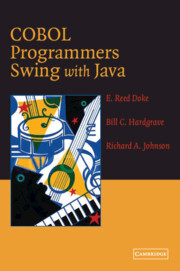Book contents
- Frontmatter
- Contents
- Preface
- Introduction
- Chapter 1 Why You Should Learn Java
- Chapter 2 An Introduction to Object-Oriented Programming
- Chapter 3 Java Structure
- Chapter 4 Defining Data
- Chapter 5 Computation
- Chapter 6 Decision Making
- Chapter 7 Loops
- Chapter 8 Arrays
- Chapter 9 Data Access
- Chapter 10 Graphical User Interfaces
- Chapter 11 Object-Oriented Development Issues
- Glossary
- Index
Chapter 3 - Java Structure
Published online by Cambridge University Press: 26 August 2009
- Frontmatter
- Contents
- Preface
- Introduction
- Chapter 1 Why You Should Learn Java
- Chapter 2 An Introduction to Object-Oriented Programming
- Chapter 3 Java Structure
- Chapter 4 Defining Data
- Chapter 5 Computation
- Chapter 6 Decision Making
- Chapter 7 Loops
- Chapter 8 Arrays
- Chapter 9 Data Access
- Chapter 10 Graphical User Interfaces
- Chapter 11 Object-Oriented Development Issues
- Glossary
- Index
Summary
OBJECTIVES
In this chapter you will study:
Java program structure;
Writing class programs;
Writing Java comments;
Naming rules & conventions;
Calling methods;
Creating objects; and
Working with subclasses.
The purpose of this chapter is to introduce you to the structure of Java programs. You will see how to write and execute simple Java programs. By working with real functioning programs, instead of just code segments, you will quickly learn the major structural differences between COBOL and Java.
This chapter begins with a program that models the Customer class from the Community National Bank system introduced in Chapter 2. This program is used to illustrate Java program structure.
We will show you how to write Java comments and review the simple rules for naming variables, methods, classes, and programs. We will also explain the Java coding conventions and style guidelines that will greatly improve the readability of your programs.
We will then execute methods in the customer class program to show how objects are created and to demonstrate calling methods. We will conclude the chapter by developing programs for the account and checking account classes to illustrate working with subclasses.
This chapter assumes you understand the following:
COBOL:
COBOL program structure
Column restrictions—area A and B
Continuation column 7
Comments and remarks
Uses of periods, commas, parentheses, spaces
Scope terminators
Rules for programmer-supplied names
Java:
OO concepts (Chapter 2)
A CLASS PROGRAM
Chapter 2 introduced object-oriented concepts and described classes and objects.
Information
- Type
- Chapter
- Information
- COBOL Programmers Swing with Java , pp. 41 - 65Publisher: Cambridge University PressPrint publication year: 2004
